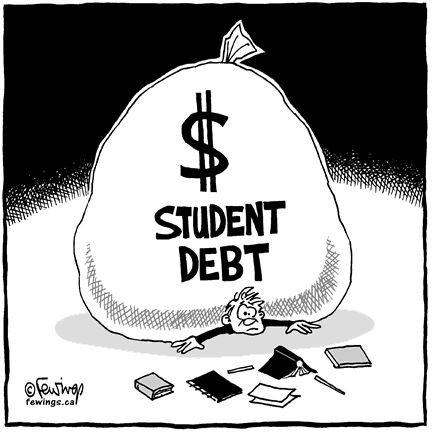
Sorry for all of those who are waiting for student loan relief (I too am one of them)…this is the latest news:
A Senate vote to restore low interest rates temporarily on some new federal student loans failed to advance Wednesday, increasing the odds that college students will rack up additional debt due to Washington inaction.
Supporters had hoped to restore the 3.4 percent rate of interest on subsidized Stafford loans, or loans made to undergraduate students from moderate- and low-income households, that had prevailed for the last few years. The interest rate on new subsidized Stafford loans doubled to 6.8 percent on July 1, as previously scheduled. The proposal on Wednesday was supported by 51 senators and opposed by 49, needing at least 60 votes in order to advance to a final vote.
"We will not give up on this issue," said Sen. Tom Udall (D-N.M.). Shortly before the noon vote, the White House said it "strongly supports" the measure.
Roughly 7 million students, or a quarter of all new federal students loans to be made this year, are affected. The average student will pay roughly an extra $1,000 over the life of the loan due to the doubling of the rate. If no further action is taken to reverse the increase, the typical incoming freshman could pay about $4,000 more in interest to pay off four years' worth of subsidized Stafford loans.
Wednesday's vote was one of a handful of recent votes that likely has disappointed students and their families. Democrats and Republicans have spent weeks trying to advance separate proposals either to restore last year's 3.4 percent rate with a promise to overhaul the entire federal student loan program in coming months, or to scrap key elements of the current scheme immediately in favor of a program that ties student interest rates to the U.S. government's cost to borrow.
The legislative jockeying comes amid a government forecast that the Obama administration will reap a $51 billion profit this fiscal year from the federal student loan program, according to the nonpartisan Congressional Budget Office. Nearly all new loans for higher education are provided by the federal government. The profit, generated thanks to near-record spreads between the government's cost to borrow and what students pay in interest, has contributed to the cumulative $1.2 trillion in educational debt carried by U.S. households.
Policymakers, including those at the Consumer Financial Protection Bureau, Federal Reserve and Treasury Department, are increasingly worried that student debt risks reducing consumption and impeding economic growth over the next several years as student debt repayment crowds out household spending, auto and home purchases, savings and retirement nest eggs.Against this backdrop of dire macroeconomic warnings, Republican and Democratic lawmakers and the White House have sought to capitalize on the political aspect of the doubled interest rate by blaming one another for failing to stop the rate hike. But despite using Twitter and other social media to gin up support for changes, their advocacy has yielded no substantive action.
No comments:
Post a Comment